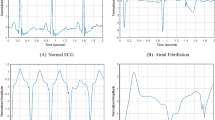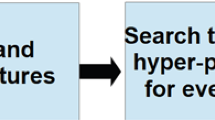Abstract
This paper aims to early arrhythmia prediction and investigate the use of robust adaptive filters to forecast the ECG signal. Different robust adaptive filters are examined for ECG prediction. Features in time and time-frequency domains have been extracted, and the Hurst index has been calculated in two domains. The performance of the SVM, KNN, and the ensemble of LogitBoost trees for model construction has been examined for detecting the occurrence of an arrhythmia in the predicted ECGs in an inter-patient scenario. Results show that pseudo-Huber adaptive filter is the best choice for ECG prediction. Also, classification performance measures besides the McNemar test show that the predicted signal is suitable to use for early arrhythmia detection with accuracy, precision, sensitivity, and specificity of at least 98\(\%\).





Similar content being viewed by others
References
Yang, H., Pan, Z., Tao, Q.: Robust and adaptive online time series prediction with long short-term memory. Comput. Intell. Neurosci. 2017, 9478952 (2017)
Cepulionis, P., Lukoseviciute, K.: Electrocardiogram time series forecasting and optimization using ant colony optimization algorithm. J. Math. Models Eng. (MME) 2(1), 69–78 (2016)
Abbas, R.: Electrocardiogram signal forecasting using iterated and direct method based on artificial neural network. J. Appl. Emerg. Sci. 1(1), 72–78 (2004)
Kansal, S., Bansod, P.P., Kumar, A.: Multivariate autoregressive model for ECG signal forecasting. Int. J. Multivar. Data Anal. 1(2), 124–139 (2017)
Sun, Z.-G., Lei, Y., Wang, J., Liu, Q., Tan, Q.-Q.: An ECG signal analysis and prediction method combined with vmd and neural network. In: 2017 7th IEEE International Conference on Electronics Information and Emergency Communication (ICEIEC), pp. 199–202. IEEE (2017)
Sun, Z., Wang, Q., Xue, Q., Liu, Q., Tan, Q.: Data prediction of ECG based on phase space reconstruction and neural network. In: 2018 8th International Conference on Electronics Information and Emergency Communication (ICEIEC), pp. 162–165. IEEE (2018)
Sayed, A.H.: Fundamentals of Adaptive Filtering. Wiley, Hoboken (2003)
Walach, E., Widrow, B.: The least mean fourth (LMF) adaptive algorithm and its family. IEEE Trans. Inf. Theory 30(2), 275–283 (1984)
Cho, S.H., Kim, S.D.: Adaptive filters based on the high order error statistics. In: Proceedings of APCCAS’96-Asia Pacific Conference on Circuits and Systems, pp. 109–112. IEEE (1996)
Mathews, V., Cho, S.: Improved convergence analysis of stochastic gradient adaptive filters using the sign algorithm. IEEE Trans. Acoust. Speech Signal Process. 35(4), 450–454 (1987)
Zhao, H., Yu, Y., Gao, S., Zeng, X., He, Z.: A new normalized LMAT algorithm and its performance analysis. Signal Process. 105, 399–409 (2014)
Eweda, E.: Global stabilization of the least mean fourth algorithm. IEEE Trans. Signal Process. 60(3), 1473–1477 (2012)
Zerguine, A.: Convergence and steady-state analysis of the normalized least mean fourth algorithm. Digital Signal Process. 17(1), 17–31 (2007)
Costa, M.H., Bermudez, J.C.: An improved model for the normalized LMS algorithm with gaussian inputs and large number of coefficients. In: 2002 IEEE International Conference on Acoustics, Speech, and Signal Processing, Vol. 2, pp. II–1385. IEEE (2002)
Thakor, N.V., Zhu, Y.-S.: Applications of adaptive filtering to ECG analysis: noise cancellation and arrhythmia detection. IEEE Trans. Biomed. Eng. 38(8), 785–794 (1991)
Lu, G., Brittain, J.-S., Holland, P., Yianni, J., Green, A.L., Stein, J.F., Aziz, T.Z., Wang, S.: Removing ECG noise from surface EMG signals using adaptive filtering. Neurosci. Lett. 462(1), 14–19 (2009)
Lee, J.-W., Lee, G.-K.: Design of an adaptive filter with a dynamic structure for ECG signal processing. Int. J. Control Autom. Syst. 3(1), 137–142 (2005)
Rakshit, M., Das, S.: An efficient ECG denoising methodology using empirical mode decomposition and adaptive switching mean filter. Biomed. Signal Process. Control 40, 140–148 (2018)
Li, Z., Derksen, H., Gryak, J., Jiang, C., Gao, Z., Zhang, W., Ghanbari, H., Gunaratne, P., Najarian, K.: Prediction of cardiac arrhythmia using deterministic probabilistic finite-state automata. Biomed. Signal Process. Control 63, 102–200 (2021)
Fujita, H., Cimr, D.: Decision support system for arrhythmia prediction using convolutional neural network structure without preprocessing. Appl. Intell. 49(9), 3383–3391 (2019)
Ghosh, S.K., Tripathy, R.K., Paternina, M.R., Arrieta, J.J., Zamora-Mendez, A., Naik, G.R.: Detection of atrial fibrillation from single lead ECG signal using multirate cosine filter bank and deep neural network. J. Med. Syst. 44, 1–15 (2020)
Mandala, S., Di Cai, T., Sunar, M.S.: Ecg-based prediction algorithm for imminent malignant ventricular arrhythmias using decision tree. PLoS ONE 15(5), e0231635 (2020)
Ebrahimi, Z., Loni, M., Daneshtalab, M., Gharehbaghi, A.: A review on deep learning methods for ECG arrhythmia classification. Expert Syst. Appl. X, 100033 (2020)
Alfaras, M., Soriano, M.C., Ortín, S.: A fast machine learning model for ECG-based heartbeat classification and arrhythmia detection. Front. Phys. 7, 103 (2019)
Azemi, A., Sabzevari, V.R., Khademi, M., Gholizade, H., Kiani, A., Dastgheib, Z.S.: Intelligent arrhythmia detection and classification using ICA. In: International Conference of the IEEE Engineering in Medicine and Biology Society, Vol. 2006, pp 2163–2166. IEEE (2006)
Tripathy, R.K., Zamora-Mendez, A., De la O Serna, J.A., Paternina, M.R.A., Arrieta, J.G., Naik, G.R.: Detection of life threatening ventricular arrhythmia using digital Taylor Fourier transform. Front. Pysiol. 9, 722 (2018)
Kandala, R.N., Dhuli, R., Pławiak, P., Naik, G.R., Moeinzadeh, H., Gargiulo, G.D., Gunnam, S.: Towards real-time heartbeat classification: evaluation of nonlinear morphological features and voting method. Sensors 19(23), 5079 (2019)
Lee, H., Shin, S.-Y., Seo, M., Nam, G.-B., Joo, S.: Prediction of ventricular tachycardia one hour before occurrence using artificial neural networks. Sci. Rep. 6, 32390 (2016)
Narin, A., Isler, Y., Ozer, M., Perc, M.: Early prediction of paroxysmal atrial fibrillation based on short-term heart rate variability. Phys. A Stat. Mech. Appl. 509, 56–65 (2018)
Xiong, K., Wang, S.: Robust least mean logarithmic square adaptive filtering algorithms. J. Franklin Inst. 356(1), 654–674 (2019)
Singh, A., Principe, J.C.: Using correntropy as a cost function in linear adaptive filters. In: 2009 International Joint Conference on Neural Networks, pp. 2950–2955. IEEE (2009)
Ashkezari-Toussi, S., Sadoghi-Yazdi, H.: Robust diffusion LMS over adaptive networks. Signal Process. 158, 201–209 (2019)
Sun, Y., Chan, K.L., Krishnan, S.M.: Life-threatening ventricular arrhythmia recognition by nonlinear descriptor. BioMed. Eng. OnLine 4(1), 6 (2005)
García-Fernández, A., Roldán, V., Marín, F.: Strategies for prediction and early detection of atrial fibrillation: present and future. EP Europace 19(4), 515–517 (2016). https://doi.org/10.1093/europace/euw131
Roychoudhury, S., Ghalwash, M.F., Obradovic, Z.: False alarm suppression in early prediction of cardiac arrhythmia. In: 2015 IEEE 15th International Conference on Bioinformatics and Bioengineering (BIBE), pp. 1–6. IEEE (2015)
Friedman, J., Hastie, T., Tibshirani, R., et al.: Additive logistic regression: a statistical view of boosting (with discussion and a rejoinder by the authors). Ann. Stat. 28(2), 337–407 (2000)
Koul, A., Becchio, C., Cavallo, A.: Cross-validation approaches for replicability in psychology. Front. Psychol. 9, 1117 (2018)
Lachenbruch, P.A.: McNemar test. Statistics Reference Online, Wiley StatsRef (2014)
De Chazal, P., O’Dwyer, M., Reilly, R.B.: Automatic classification of heartbeats using ECG morphology and heartbeat interval features. IEEE Trans. Biomed. Eng. 51(7), 1196–1206 (2004)
Author information
Authors and Affiliations
Corresponding author
Additional information
Publisher's Note
Springer Nature remains neutral with regard to jurisdictional claims in published maps and institutional affiliations.
Rights and permissions
About this article
Cite this article
Ashkezari-Toussi, S., Sabzevari, V.R. Early arrhythmia prediction based on Hurst index and ECG prediction using robust LMS adaptive filter. SIViP 15, 1813–1820 (2021). https://doi.org/10.1007/s11760-021-01918-1
Received:
Revised:
Accepted:
Published:
Issue Date:
DOI: https://doi.org/10.1007/s11760-021-01918-1




